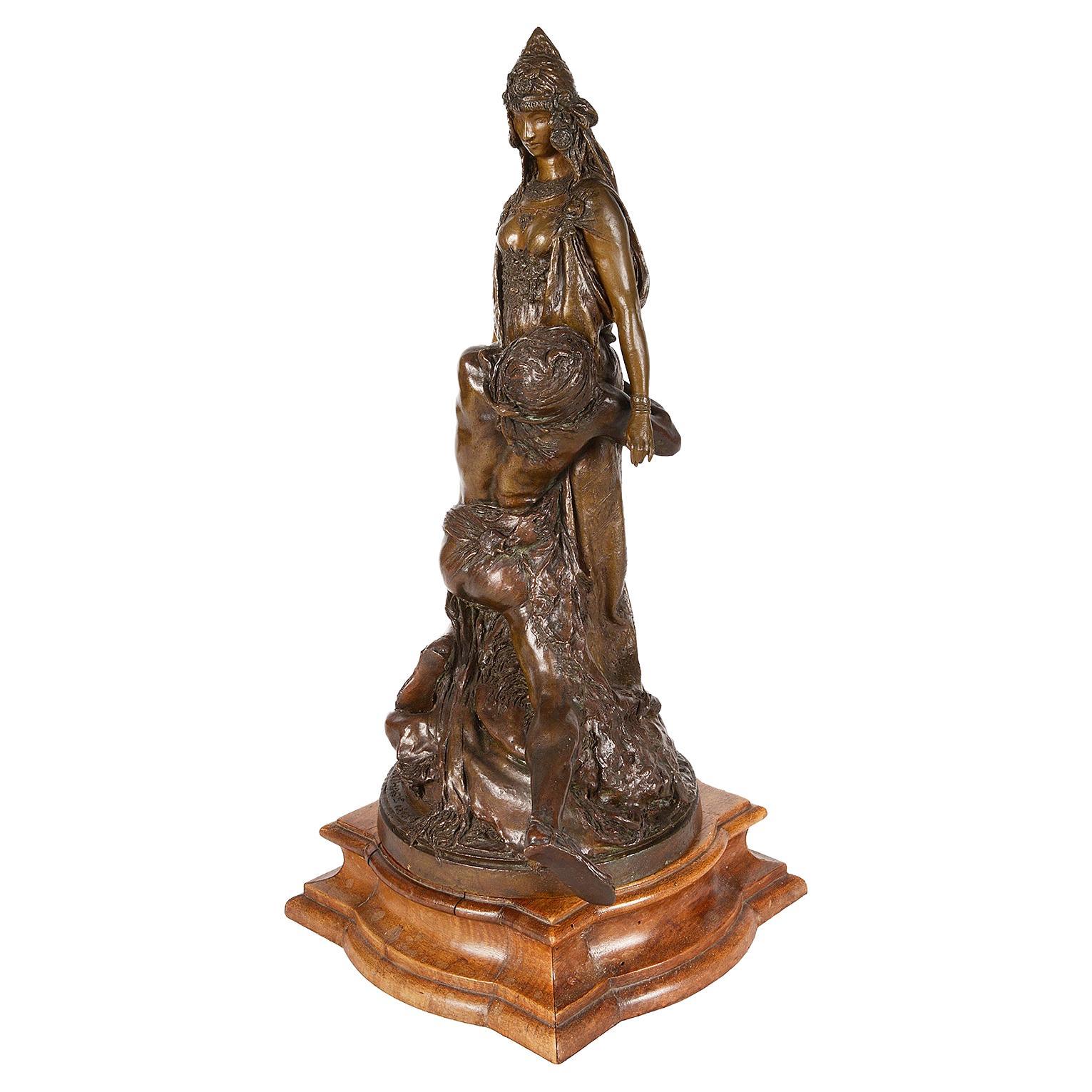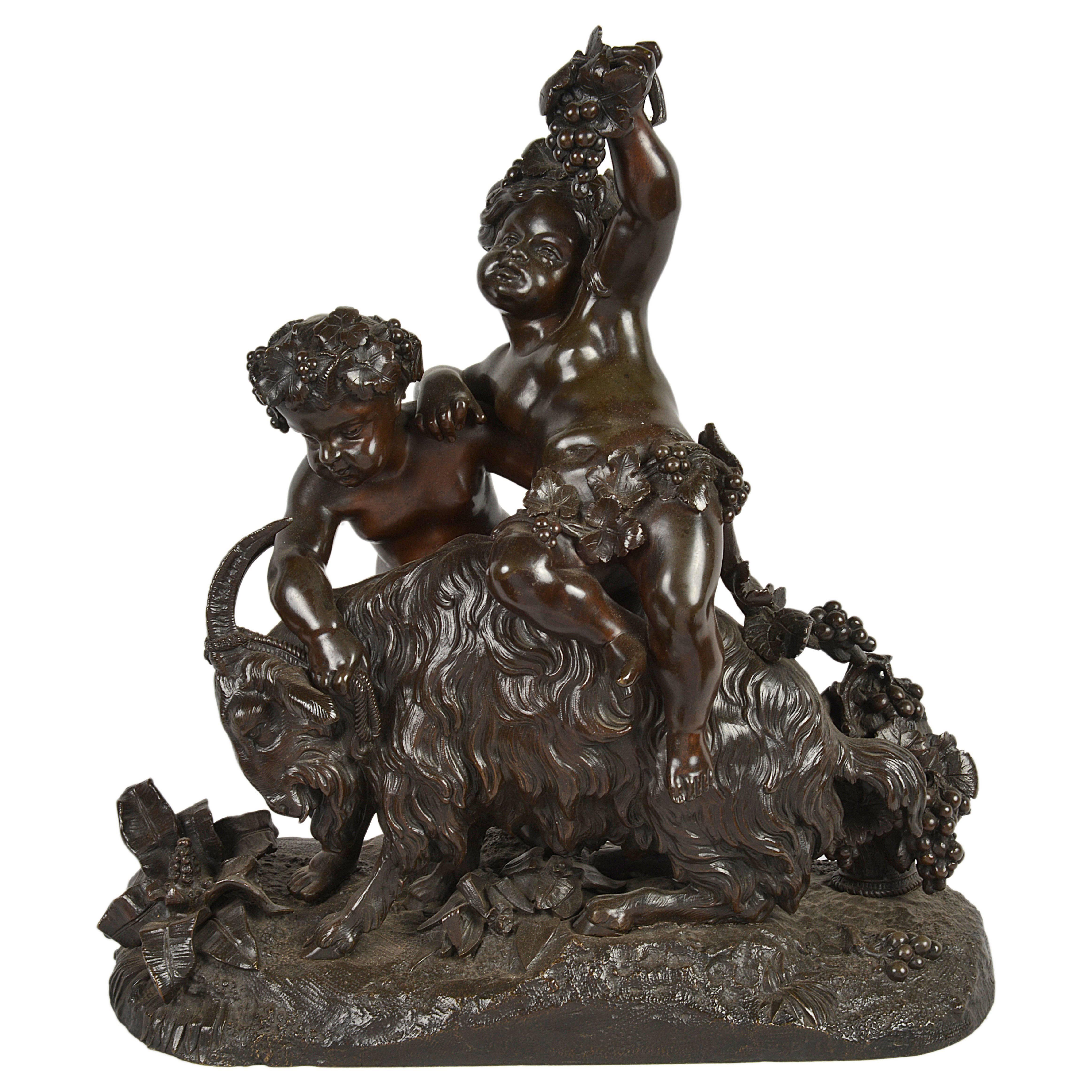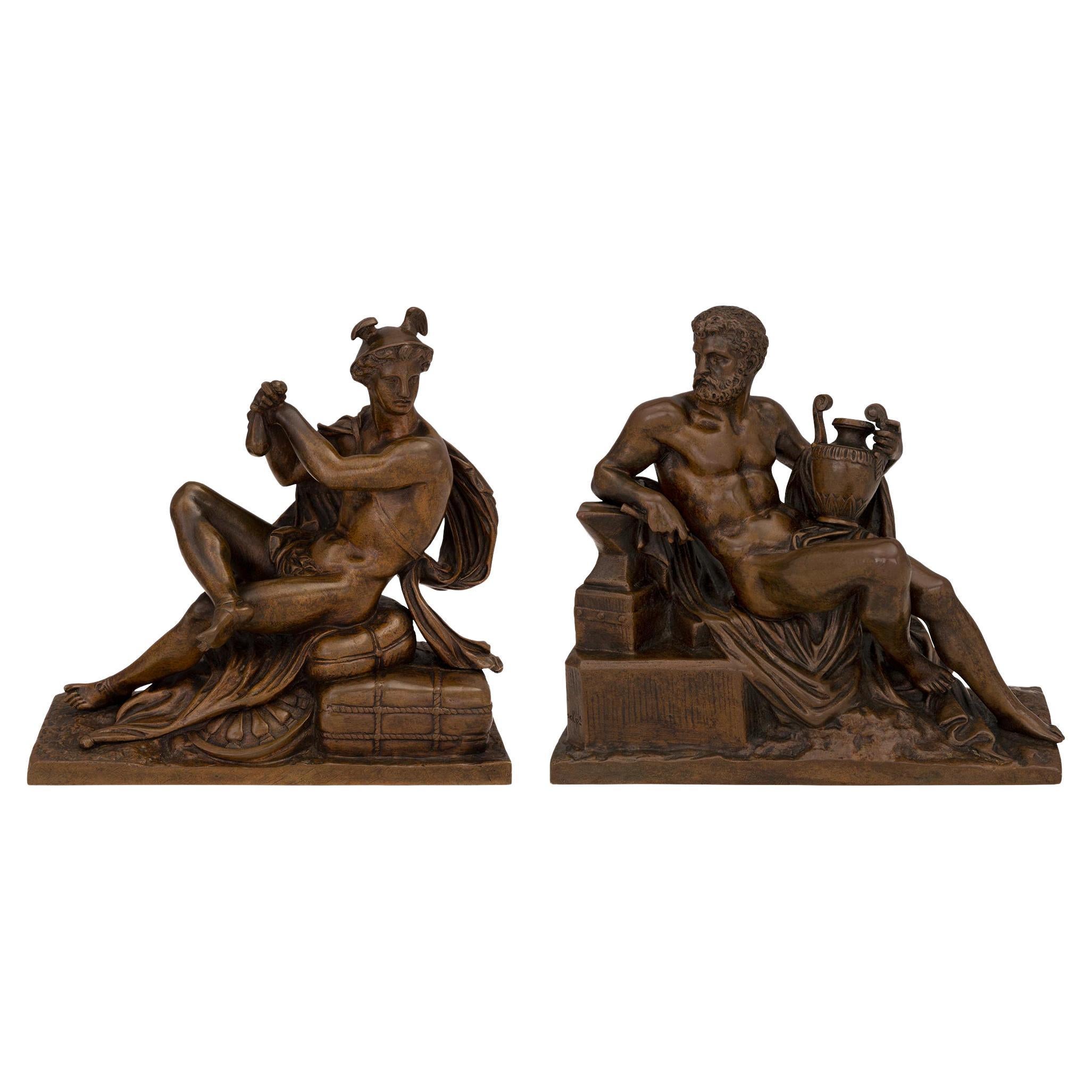Items Similar to 19th Century French Bronze Group ‘Carthage’ by Theodore Riviere
Want more images or videos?
Request additional images or videos from the seller
1 of 9
19th Century French Bronze Group ‘Carthage’ by Theodore Riviere
About the Item
A 19th century French bronze group ‘Carthage’ by Theodore Riviere, cast by Susse Frères.
Signed ‘THEODORE-RIVIERE’ and titled "Carthage".
Stamped with foundry mark "Susse Frs Edt", and the cahet "SUSSE FRERES FONDEURS PARIS" and the monogram "MM" to the base.
The subject of this work was taken from Gustave Flaubert's novel, Salammbô, published in 1862.
- Creator:Susse Freres (Manufacturer),Théodore Rivière (Sculptor)
- Dimensions:Height: 16.54 in (42 cm)Width: 7.88 in (20 cm)Depth: 7.88 in (20 cm)
- Materials and Techniques:Bronze,Patinated
- Place of Origin:
- Period:1910-1919
- Date of Manufacture:circa 1910
- Condition:Wear consistent with age and use.
- Seller Location:Brighton, GB
- Reference Number:Seller: B758401stDibs: LU1028024625742
About the Seller
5.0
Recognized Seller
These prestigious sellers are industry leaders and represent the highest echelon for item quality and design.
Platinum Seller
These expertly vetted sellers are 1stDibs' most experienced sellers and are rated highest by our customers.
Established in 1964
1stDibs seller since 2014
48 sales on 1stDibs
Typical response time: 1 hour
Associations
The British Antique Dealers' AssociationLAPADA - The Association of Arts & Antiques Dealers
More From This SellerView All
- 'Le Puits Qui Parle' an Exhibition Bronze, Paul Eugène Mengin French, circa 1900By Paul Eugène Mengin 1, Susse FreresLocated in Brighton, West Sussex'Le Puits Qui Parle' (The Speaking Well) - An Important Exhibition Bronze Group, by Paul Eugène Mengin. Signed to the cast 'P MENGIN', and inscri...Category
Early 20th Century French Figurative Sculptures
MaterialsBronze
- Pair of Restoration Period Gilt-Bronze Figural Groups. French, circa 1830Located in Brighton, West SussexAn exceptional pair of restoration period gilt-bronze figural groups, allegorical of hunting and fishing. Each group is set on a naturalistically modelled base and finely modelled...Category
Antique Early 19th Century French Napoleon III Figurative Sculptures
MaterialsBronze
- Pair of Restoration Period Gilt-Bronze Allegorical Groups. French, circa 1830Located in Brighton, West SussexAn exceptional pair of restoration period gilt-bronze allegorical groups depicting music and wine. Each group is set on a naturalistically modelled base and finely modelled and ch...Category
Antique Early 19th Century French Napoleon III Figurative Sculptures
MaterialsBronze
- ‘Gloria Victis’, A Patinated Bronze Figural Group by Mercié, Cast by BarbedienneBy Ferdinand BarbedienneLocated in Brighton, West SussexA Patinated Bronze Figural Group of ‘Gloria Victis’ (‘Glory to the Vanquished’), Cast by Ferdinand Barbedienne from the Model by Marius-Jean-Antonin Mercié (French, 1845-1916). ‘Gloria Victis’ (‘Glory to the Vanquished’). Bronze, gilt and dark brown patina. Signed 'A. Mercié', with foundry inscription 'F. BARBEDIENNE, Fondeur. Paris.' and A. Collas reduction cachet. The integral base titled 'GLORIA VICTIS'. This cast is part of a limited edition by the Barbedienne Foundry. France. Circa 1880. ‘Gloria Victis’ is one of the most recognisable and important works of sculpture of the nineteenth century and a definitive image of France’s historic national identity. The figure of glory, winged and wearing armour, carries a dying young warrior heavenwards towards fame and immortality. The compositional daring of the group must be admired for balancing two figures on the minimal support of one foot, wings spread in the moment before taking flight. Mercié was a student at the French Academy of Rome when the Prussians invaded France in 1870. Shortly after the war had begun, he executed a group depicting the figure of Fame supporting a victorious soldier. When news reached Mercié in Rome that the French had surrendered, he decided to alter his group, replacing the victorious soldier with a defeated casualty, thus transforming an allegory of ‘Glory to the Victors’ into one of ‘Glory to the Vanquished’. Completed in 1872, a year after the defeat of French soldiers against the Prussian army, the statue personifies a defeated but heroic France. The title is also a reversal of the famous formula, ‘Vae Victis’ (Death to the Vanquished), which the Gallic general Brennus exclaimed upon defeating the Romans in 390 BC. The figure of the fallen soldier was thought to represent Henri Regnault, a fellow sculptor of Mercié who was killed on the last day of fighting. Measuring 317 cm. high the original group of ‘Gloria Victis’ was unveiled in plaster at the Salon of 1872. It was bought by the City of Paris for the sum of twelve thousand francs and then cast in bronze by Victor Thiébaut for eight thousand five hundred francs. The bronze was exhibited at the Salon in 1875 and first placed in Montholon Square in the 8th arrondissement. In 1884 it was transferred to the courtyard of the Hôtel de Ville and in 1930, it entered the collection of the Musée du Petit Palais, where it can be seen to this day. The Thiébaut Frères foundry also cast Gloria Victis bronzes for the cities of Niort (requested 1881) Bordeaux (requested 1883), Châlons-sur-Marne (today, Châlons-en-Champagne; requested 1890), and Cholet (requested 1901). In 1905, the Danish brewer and art collector Carl Jacobsen was permitted to have an exact cast made of the original sculpture in Paris, on condition that the base was made 2 cm lower and bore the inscription “Original tilhører Paris By” (The original belongs to the City of Paris). It too was cast by the Thiébaut Frères foundry. Gloria Victis was one of Jacobsen’s most important and his last acquisition. Today it has been returned to its original position in the Winter Garden at Glyptoteket, Copenhagen, Denmark. The full-size plaster was shown again at the Paris Expositon universelle of 1878 alongside a bronze reduction by Barbedienne. By this time Antonin Mercié had entered into a commercial edition contract with the Ferdinand Babedienne foundry to produce bronze reductions of Gloria Victis, his most famous work. Gloria Victis is first recorded to have been produced in three sizes and by 1886 Barbedienne’s ‘Catalogue des Bronzes D’Art’ lists six sizes measuring 3/5, 9/20, 7/20, 3/10, 6/25 and 2/10, of the original. These reductions were produced by an invention of Barbedienne’s business partner Achille Collas. The Collas reducing machine was a type of complex mechanical pantograph lathe that enabled sculpture to be mathematically measured and transcribed to scale, in the round, thus making a reduced size plaster from which a bronze could be cast. Mercié's modern sculpture had become an instant classic, even receiving an entry in the Nouveau Larousse Illustré. The success of the group undoubtedly lay in the fact that it was admired not just on an aesthetic level, but also on a patriotic level, particularly in its commemoration of heroism in defeat. Immediately ‘Gloria Victis’ was recognised as a national artwork, capable of arousing patriotism and casts were ordered from Barbedienne as local memorials commemorating the war’s dead for cities across France. ‘Gloria Victis’ was considered so much a part of France’s national identity that for the 1900 Paris Exhibition, Ferdinand Barbedienne’s nephew Gustave Leblanc, loaned a bronze example to feature as part of l’Exposition centennale de l’art français. Literature: For an interesting account of the process of creating a reduction in bronze of the Gloria Victis by Barbedienne and illustrations of the casting and finishing of the bronze see: 'Ferdinand Barbedienne': Theodore Child; Harper's new monthly magazine, Volume 73, Issue 436, September 1886. ‘Contemporary French Sculptors’: The Century, Volume 33, Issue 3, Jan 1887. ‘Modern French Sculpture’: Harper's new monthly magazine, Volume 76, Issue 452, January 1888. S, Lami, ‘Dictionnaire des sculpteurs de l'Ecole française au dix-neuvième siècle’, Tome III. G.-M., Paris, 1914, p. 432. Peter Fusco and H.W. Janson, The Romantics to Rodin: French Nineteenth Century Sculpture from North...Category
Antique 19th Century French Figurative Sculptures
MaterialsBronze
- A Japanese Bronze Group of an Elephant And Tigers, By Genryusai SeiyaLocated in Brighton, West SussexA Large Japanese Bronze Group of an Elephant And Tigers, By Genryusai Seiya. Signed in hiragana script 'Seiya Zo'. This large figural group is naturalistically cast with a finely c...Category
Antique 19th Century Japanese Animal Sculptures
MaterialsBronze
- 'Bacchantes', a Fine Patinated Bronze Figural Group After Clodion, circa 1870By Claude Michel ClodionLocated in Brighton, West Sussex'Bacchantes', a fine patinated bronze figural group after Claude Michael Clodion, French (1738-1814). French, circa 1870. Signed 'Clodion' to the base and inscribed 'BACCHANTE...Category
Antique Late 19th Century French Figurative Sculptures
MaterialsBronze
You May Also Like
- Carthage, A Patinated Bronze Group by Theodore RiviereBy Théodore RivièreLocated in Brighton, Sussex‘Carthage’ – A Fine Patinated Bronze Group of Salammbô at Mathô's, By Theodore Riviere, Signed ‘THEODORE-RIVIERE’ and titled "Carthage". The s...Category
Early 20th Century Figurative Sculptures
MaterialsBronze
- Lost-Wax Bronze Sculpture by Théodore Rivière, Titled 'Carthage'By Théodore RivièreLocated in London, GBA lost-wax bronze sculpture by Théodore Rivière, titled 'Carthage' French, Late 19th Century Height 41cm, width 23cm, depth 18cm This superb lost...Category
Antique Late 19th Century French Neoclassical Figurative Sculptures
MaterialsBronze
- Grand Tour Bronze, Roman Woman, France, 19th Century by Susse FreresBy Susse FreresLocated in West Palm Beach, FLThis bronze was produced by the firm of Susse Freres in France at the end of the 19th century during the "Grand Tour" of Europe. The piece has aged to a beautiful soft coloration. F...Category
Antique Late 19th Century French Neoclassical Revival Figurative Sculptures
MaterialsBronze
- Classical 19th Century Bacchus Bronze GroupLocated in Brighton, SussexA very pleasing 19th century French Bacchus influenced bronze group, depicting two putti playing with a ram, garlands of vine leaves and grapes. Signed.Category
Antique 19th Century French Figurative Sculptures
MaterialsBronze
- 19th Century Bronze Group After FalconetBy Étienne Maurice FalconetLocated in Paris, FRBronze group with brown patina featuring Cupids fighting over a heart after Etienne-Maurice Falconet (1716-1791). This work had a great success in the second half of the 19th century...Category
Antique 19th Century French Louis XVI Figurative Sculptures
MaterialsMarble, Bronze
- Pair of French 19th Century Neoclassical St. Patinated Bronze StatuesBy Susse FreresLocated in West Palm Beach, FLA splendid and true pair of French 19th century Neo-Classical st. patinated bronze statues of Hermes and a nobleman, signed and stamped by Susse Frère...Category
Antique 19th Century French Neoclassical Figurative Sculptures
MaterialsBronze





